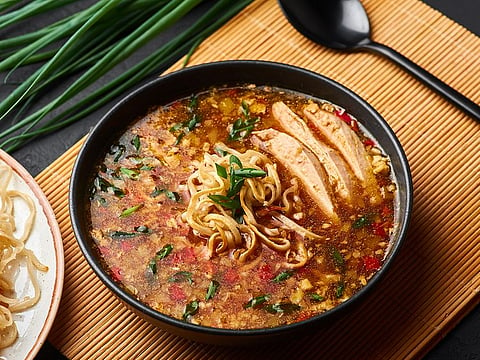The curious case of the Indian Chinese manchow soup
Is it from Kolkata? Is it from Meghalaya? Read on to find out!

This story begins in 18th century Kolkata in India. We are talking of a time when Kolkata was called ‘Calcutta’; a time when a few Englishmen prospered under the East India Company (EIC); a time when the only mode of transport to get around was a horse-drawn carriage. And also a time, when Hakka Chinese traders settled in the city, which was the former capital of India during the British reign.
Chinese Silk traders, dentists, carpenters and leather tannery owners – these immigrants were able to find a steady income while staying in the bustling city, away from home. They could find delicious meals but it wasn’t the same as eating a meal in China. They needed a permanent solution, which was when they started experimenting with local ingredients and soon set up small-scale eateries.
And so, the Indo-Chinese cuisine was born, from where the manchow soup takes its roots.
A combination of the two cuisines, Indian-Chinese or ‘Indo-Chinese’ cuisine features food that’s been deep-fried and heavily spiced, with its core ingredients being soy sauce and vinegar. However, Indo-Chinese cuisine has its distinction as well. For example, the famed Schezwan sauce is inspired by the Chinese ‘Sichuan’ cooking style, which uses dried red chillies as a substitute for Sichuan peppercorns.
The cooking style also varies when it comes to Indo-Chinese cooking. For one, it is called Manchurian style cooking, where vegetables and meat are bathed and then fried in a soy-based sauce, along with native Indian ingredients like ginger, garlic and green chillies. The addition of onions and bell peppers are also quite common in Manchurian cooking.
But what exactly is the ‘Manchurian’ style of cooking?
Some claim that it comes from Manchuria, which is a historical and geographic region that combines Russia and China in Northeast Asia. However, it bears no resemblance to the region’s cuisine, which uses millet, soybean, peas, corn and broomcorn as staple ingredients.
The word ‘Manchurian’ first emerged in 1975 by Nelson Wang, who was born to Chinese immigrants in Kolkata. He was a resident cook at the Mumbai Cricket Club of India when he was approached by a customer who asked him to create a new dish that wasn’t on the menu. Baffled by the request, Wang decided to give it a shot anyway.
He began by combining the basic ingredients of an Indian dish – ginger, garlic and green chillies. However, when it came to adding spice, he decided to skip the traditional garam masala and add soy sauce and cornflour instead. He then added meat and garnished the dish with spring onions, and the result of it all gave birth to the famed Chicken Manchurian.
With its instant popularity, new dishes were created, those of which included the manchow soup.
Manchow soup originates from Meghalaya but is popular in Kolkata
Manchow is short for Manchuria, they say. But this soup in particular has a different history altogether. Some say its name caught the tongues of many by addressing ‘Manchuria’ as ‘manchow’. However, chow in Indo-Chinese cuisine means noodles, which is why we have chowmein or stir-fried noodles.
When we decode the manchow soup, it isn’t difficult to understand that the hot appetizer is made using a balanced blend of sweet and spicy flavours. That is its unique selling proposition.
A union of vegetables, the dish is quick to make and devour as well. Spring onions, carrots, cabbage, green beans, form the base of the dish. However, there are no limitations to the type of vegetables you can add. Perhaps, that is the beauty of the soup. Nothing is ever too much or too little, for the key element of all lies in the sauce.
Sautéed in a generous amount of oil, the vegetables lie submerged in a translucent, thick and heavily spiced brown layer of soy sauce, vinegar, cornflour, ginger, garlic, green chillies, salt and pepper powder. The best part of drinking the soup lay in the crunch that comes from fried noodles placed atop. And the ideal season to sip a spoonful is during the winter when you need something warm for company.
Today, every other street food stall in the northeast of India accommodates the manchow soup. Not to mention, the tastiest bowl can be found in the popular Chinatowns of Tiretta Bazaar and Tangra in Kolkata, India.
No one knows the complete origin story behind it and the manchow soup continues to be a delicious mystery. For all we know, it could have been made by someone who accidentally fried noodles while making a steaming bowl of it and decided to drink the mix of spiced vegetables in water as soup instead of discarding it.
But let’s not get carried away, for it's best to relish certain dishes to your heart’s content rather than solve mysteries. Don’t you think?
Tell us about your food stories on food@gulfnews.com
Sign up for the Daily Briefing
Get the latest news and updates straight to your inbox




